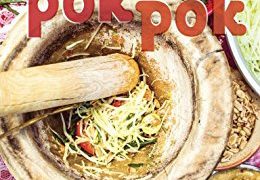“Kill the crab.”
So begins one of the recipes in Pok Pok, the cookbook spinoff of Andy Ricker’s eponymous Portland restaurant specializing in Northern Thai cuisine. Ricker doesn’t shy away from the fact that this cookbook is for the committed, for those ready to learn how to kill a crab before dinner. Even if you choose to start with your ingredients already incapacitated, you will still be in for an evening of work. Making your own curry paste is a given since the paste is the central flavoring component of most dishes. Ricker demands more than just making the paste by hand; he describes the two different types of mortar and pestles that you should buy to do so. You will have to track down not only the infamous live crabs, but also blood and banana leaves. Substitutions are frowned upon.
Ricker understands what he is asking, and in the introductory materials he reassures the reader several times that this is necessary. “Some dishes can’t be replicated at home with concessions to convenience,” he warns. If you do adapt the dishes to the point of being unrecognizable, he will sigh, but understand, because he “wouldn’t be upset if it simply helped you make great food at home.” In testing these recipes, I tried to follow the instructions as closely as seemed reasonable. I didn’t go out and buy a mortar and pestle; I used my coffee grinder. My grocer didn’t have fresh Chinese noodles so I settled for dried; which led to extra complication and a small disaster later when I had to separately fry some, but that was my own fault. Even after making adjustments to the recipes to make it easier for me as a home cook, my testing companion and I still found it to be quite a lot of work.
When we sat down to eat our hard earned meal, all our suffering was redeemed. Everything was unbelievably delicious. I don’t think I’ve tested another cookbook where every single dish I tried was “Oh Em Geeeeeee!” good. This became the type of meal where dinner conversation disappears after the first bite and all you can hear is slurping and burping. The Khao Soi Kai, a coconut-based curry from the Ching Mai province, was rich and fragrant. The fried egg salad caused great skepticism as we were preparing it. The proportions of greens and eggs seemed off; the dressing tasted too spicy to eat. When it all came together, it turned out that Ricker was exactly right about everything and we were wrong to doubt. The stir fried water spinach was so delicious we fought over who would have the last serving. The sauce used in that recipe is going to become my default stir fry sauce from here on out. This might have been one of the tastiest dinners I’ve ever cooked in my tiny apartment kitchen.
Going into this book expecting the immersive education experience of a culinary tour guide book like Burma: Rivers of Flavor may lead to disappointment. Ricker editorializes too often, compromises too little. If you approach this cookbook as you might a celebrity chef’s manifesto instead, with a little humility and a lot of determination, you will benefit more from the experience, and the delicious smells of Northern Thailand wafting about your kitchen will be your rewards.
